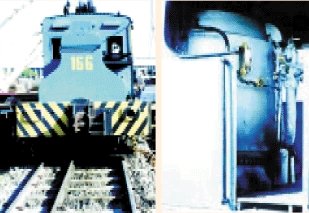Still in Service
 |
No. 166 in the middle of a day’s work at the Amsted-Maxion yard |
Steam engines that are still running are rare in Brazil, almost all having been refurbished and under the care of the ABPF, hauling sightseeing trains over short distances and being used in soap opera filming. Steam locomotives operating in original conditions for railroads are extremely rare. There are some unconfirmed reports of some such engines pulling sugar cane in mills in Pernambuco. However, there are two engines that are easy to observe working at the Amsted-Maxion railroad car factory in Cruzeiro (SP). All you need to do is go to the bridge that crosses the Paraiba do Sul River in the middle of the city and you will see, right in the factory yard, two English Sentinel locomotives painted in blue valiantly pulling flatbed cars loaded with steel plate.
 |
|
| The front looks like a diesel but the locomotive is 100% diesel | The vertical boiler is inside the cabin |
The engines, for wide-gauge track, were ordered by the São Paulo Railway in 1931 and acquired by the Fabrica Nacional de Vagões (FNV) two years after it was established in 1945 in Cruzeiro (SP). At the time, Cruzeiro was an important rail switching center in São Paulo for the EF Central do Brasil and of the southern line of Rede Mineira de Viação. The FNV was one of the main railroad manufacturing companies — in fact one of the country’s first heavy manufacturers. In 1981, Fabrica Nacional de Vagões became FNV Veículos e Equipamentos, in 1983 Engesa/FNV, in 1990 Iochpe-Maxion and in 1996 Maxion Fundição e Equipamentos Ferroviarios until, finally, in 2000, it became Amsted-Maxion Fundição e Equipamentos Ferroviarios. Until today the steam locomotives continue to perform their same service at the location.
 |
|
| The vertical cylinders, with the drive chains (lower right) | João Lobato Uchoa has been a Sentinel engineer for 20 years |
The Sentinels are among the most heterodox engines around. Their pistons and the boiler are mounted vertically and in line, which makes them look like a diesel engine when, in fact, they are legitimate steam engines. Their manufacturer, the Sentinel Wagon Works, was better known for steam-driven trucks, light vehicles built for the size of the roads of the time. That is why the Sentinels, with a 0-4-0 wheel set, weigh less than 20 tons. The boiler, however, is a high pressure unit (275 psi). According to João Nupomuceno, an Amsted-Maxion engineer, the Sentinels can pull 10 cars loaded with steel plate that arrives on the MRS line.
Their speed is low — 30 kph at maximum — but no more than this is necessary for the maneuvering services they provide. The transmission is through chains similar to those on bicycles that link the driving rods to two crankshafts turned by the vertical pistons. The chains are permanently bathed in an oil pan placed just below the axles. The locomotives are not equipped with conventional brake shoe-equipped brakes, being halted using counter-steam. The boiler is oil-heated and the water and fuel tanks are from the engine itself.
According to the Sentinel Drivers Club of Srewbury, England (www.sentinel-waggons.co.uk), today there are about 40 existing Sentinels in the world, between trucks and locomotives. And it is very probable that only the Amsted-Maxion are the only ones that continue in regular service.